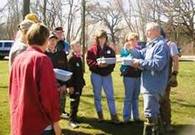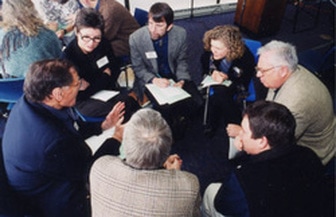Methods
|
As our work is distinct from that of other firms working on similar topic areas, it may be helpful to provide some detail about how our work differs. Project descriptions give you the general idea. But since both the conflict management and community & environment aspects of Convenor’s work involve some strategies that may not be readily apparent, we describe them here.
|

Community & Environment consulting
The name gives it away. Elaine’s work is about how to engage members of the ‘community’ -- whether that is a community of practice, a belief community, or a geographic community -- in a decision-making process that will influence environmental conditions. In her work, Elaine applies a collaborative philosophy. Holding to this philosophy while also creating project ‘deliverables’ requires discipline as well as a commitment to the participatory approach. Resources and studies conducted under Elaine’s supervision are each developed in partnership with an advisory committee, working through a process involving needs assessment, identifying practical solutions and techniques for enabling participants to build skills, pilot testing, evaluation, and reporting. Two projects exemplify this approach: Both agencies share the goal of promoting environmental management via local decision making and voluntary compliance with regulations. This project was designed to learn more about how the two agencies could learn from each other and work together when goals overlap. The Study methodology and results are reported in A Discussion Paper.
|
 At a Theory to Practice meeting: Morton Deutsch and colleagues At a Theory to Practice meeting: Morton Deutsch and colleagues
Negotiation and conflict management: A working method for complex discussions
The examples which follow are from a single long-term project. They illustrate a working method for developing collaboration between extremely busy people. In this project the people involved were usually unpaid, and often collaborated in large numbers, with considerable depth of effort, and with people they did not know. Our working method did not start with this project, and it developed further afterwards. But the five years of the Theory to Practice project were pivotal, a period in which this approach was refined over many related events and experiments. Theory to Practice, a national project, tackled a problem that is not unique to conflict management but which has particularly serious consequences in a rapidly developing field: the disconnection between what people who see themselves as "doers" know, or think they know, and what those who see themselves as researchers and "idea people" know, or think they know. We set out to develop more sophisticated and more consistent linkages between these two broad groups. Chris Honeyman, managing partner of CONVENOR, was the project's director and principal investigator, and Mediation Center (Hamline University, St. Paul, MN) was the grant administrator. The project was generously funded by the William and Flora Hewlett Foundation for an initial two-year term (1997-99), and in 1999 the Foundation awarded a major grant for a further three years. (In 2002 the project was succeeded by the Broad Field project, also generously funded by Hewlett.) One feature that was constant throughout was its expert steering committee, including both scholars and practitioners drawn from diverse backgrounds. As you will see, the project also benefited from a long list of other colleagues, in a wide variety of practice and academic settings. Below you can find a summary of the major outputs and results, including links to some of the project's publications. Events and Presentations (examples from among many) While the writings resulting from a stream of discussions were numerous (see below), for this particular project's purposes the meetings themselves were just as important, if not more so: We were, after all, trying to get people more used to working together for the future. The following meetings are just a sample.
Public Sessions Sessions exploring project issues were held at a number of national and regional conferences, including:
Theory to Practice discussions were also held at a number of the Hewlett Theory Centers (a group of 19 academic centers awarded long-term support from the Hewlett Foundation between 1980 and 2005; after 1996, the Hewlett Foundation honored Convenor by including us with these academic groups for a variety of purposes.) Particularly illuminating discussions of this kind were hosted by Georgetown University, ICAR/George Mason University, Institute for Civil Justice/RAND, Institute for Legal Studies/University of Wisconsin, CUNY/John Jay College of Criminal Justice, UCLA/Western Justice Center, Columbia Law School, and the Stanford Center on Conflict and Negotiation, among others. Outstanding panels of academics and practitioners assembled for these sessions, and the resulting discussions were routinely influential in the project's publications, but there were too many to provide separate accounts of them all here. Translating Research into practitioners' language At one Theory to Practice discussion, held at RAND's Institute for Civil Justice, a highly experienced economist remarked "When I write, almost the entire length of the report is an effort to demonstrate how and why I reached my conclusions, because I know that some other scholar is going to challenge my methodology. But for a reader who doesn't care about that, the essentials could be said in a page or two." The Translating Research sub-agenda originally offered a many-page set of examples of how long, complex and sometimes — gasp! — turgid research reports can be rewritten to make their essential content more accessible. (These have since been effectively superseded by various elements of the Rethinking Negotiation Teaching project.) Selected Publications Here There Be Monsters, by Christopher Honeyman, Bobbi McAdoo and Nancy Welsh (with dozens of colleagues participating), draws together what we have learned in years of work on creating better integration of scholars' and practitioners' knowledge across the conflict resolution field. It became the principal article in The Conflict Resolution Practitioner, a monograph published by the Office of Dispute Resolution, Supreme Court of Georgia to highlight the need for integration of scholarship and practical wisdom in conflict resolution. Cracking the Hard-Boiled Student is a nuts-and-bolts description of experiments at the U.S. Department of Justice that led to creation of exercises that "get across" important social psychology findings — relevant to practice, yet rarely read by practitioners. By Jeffrey M. Senger and Christopher Honeyman, and published in the monograph described above, The Conflict Resolution Practitioner. Not Quite Protocols: Toward Collaborative Research in Dispute Resolution describes one of the Theory to Practice project's "moveable feasts" — an effort to start to define terms on which scholars and practitioners might work together more productively, in the face of working environments on both sides whose influence can be insidious. By Christopher Honeyman, Barbara McAdoo and Nancy Welsh, with 21 colleagues. This article was first published in Conflict Resolution Quarterly, Fall 2001. Have Gavel, Will Travel: Dispute Resolution’s Innocents Abroad describes another moveable feast, to begin to examine the risks created by American conflict resolution practitioners and scholars working abroad — often, in cultures they don't take the time to understand. By Christopher Honeyman and Sandra Cheldelin This article was originally published in Conflict Resolution Quarterly, Spring 2002. The Wrong Mental Image of Settlement discusses a distortion in what people think "settlement" means — a distortion that has serious consequences for the field. By Christopher Honeyman. This article was originally published in Negotiation Journal, January 2001. System Disorders: Trying to Build Resolution into Managed Care is the report of another "moveable feast" — this time, examining the huge but often hidden problems created by disputes among health care professionals as well as between HMOs and their plan participants. By Brad Honoroff and Christopher Honeyman. This article was first published in Alternatives, October 2001. Guide to Dispute Resolution Practitioners and Researchers (no longer available). The project created the most thorough directory of sophisticated mediators and other neutrals in the field. After publishing two editions on paper, the third edition (2001, and maintained for years, but no longer current) was incorporated into the CRInfo database. It included a "reverse directory" of highly regarded scholars and researchers willing to hear from practitioner groups, and a cross-index intended to serve, in effect, as the field's first speaker's bureau. ADR Practitioners and Researchers in a "Moveable Feast" This article by Chris Honeyman describes why it was necessary to invent a new kind of encounter to get some key discussions going seriously. It appeared in the June, 1999 issue of Alternatives to the High Costs of Litigation (CPR, New York). Theory v. Practice in Dispute Resolution The initial article describing the Theory to Practice project was published in the July-August 1997 issue of Alternatives to the High Cost of Litigation, the newsletter of the CPR Institute for Dispute Resolution, New York. The version shown here has been slightly updated. A special issue of Mediation Quarterly on the project appeared in Summer 1998. For the first time, this juxtaposed significant scholarly analyses of particular aspects of dispute resolution with the reactions of expert practitioners. Frames of Reference is Christopher Honeyman's anchor article in the special issue, and discusses some psychological disincentives that impede communication between scholars and practitioners. Not Good For Your Career This Honeyman article explores some of the disincentives practitioners and academics face when contemplating working together. Published January 1998 in Negotiation Journal. Confidential, More or Less This short Honeyman article on the disparity between both the academic and the usual practitioner perceptions of what can be kept confidential in mediation, and the realities, was published in the American Bar Association's Dispute Resolution Magazine (January 1999, pp. 12-13.) The Incredible Disappearing Profession Another short Honeyman article, on the disparity between the ADR field's development of quality control mechanisms and our failure to implement them broadly, focuses on the consequences for how the field is beginning to be perceived. Recently published in CONSENSUS, newsletter of the MIT Public Disputes Program(Winter 1998-99.) On Covering Dispute Resolution This Honeyman article focuses on the need for journalists to recognize a sea change in the handling of conflict for what it is. Published in the January-February, 1999 issue of IRE Journal, the newsletter of the society Investigative Reporters and Editors. A version modified to address dispute resolution practitioners' interests was published as "Viewpoint: On covering dispute resolution — How to report on a systemic change in the legal process" in the August 4, 1999 issue of ADR Report (Pike & Fischer / BNA.) Doing it Yourself Getting other groups to adopt the ideas of Theory to Practice was, of course, an end goal throughout. This required not just leading and providing examples, but helping those groups which were willing to take up such experimentation for themselves and with their own constituencies. An early example was the Institute for Conflict Analysis and Resolution (ICAR; since renamed School/SCAR) at George Mason University, which became a regular partner of the project for years thereafter. For example, ICAR held a one-day regional symposium (in conjunction with the District of Columbia-area chapter of SPIDR and the Northern Virginia Mediation Service) on the nexus of theory and practice. The day's program became an example of what can be done locally or regionally in a number of cities which incorporate both strong communities of practitioners and significant numbers of academics interested in dispute resolution. Upon the conclusion of the Theory to Practice project, we invited others to take action in that "space," and to seek our advice if needed; in the years since, we have responded to many such requests. And the many groups who had already hosted "moveable feasts" and other events in collaboration with the project continued to demonstrate the interest that could be generated locally. Some have gone further, and have mounted national or international meetings, discussions and writings that have drawn in many ways from this initiative. |